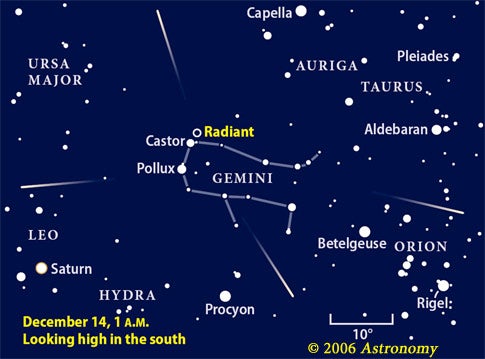Get ready for a flurry of “falling stars” Wednesday night. That’s when the Geminid meteor shower reaches its annual peak. After sunset Wednesday, observers should start looking for shooting stars high in the south.
Of the year’s regular meteor showers, the Geminids produce the strongest display — rich in bright, moderately fast meteors. Observers under clear, dark skies will see a “shooting star” streak through the heavens every few minutes. Geminid meteors move relatively slowly (79,200 mph), and many leave trails that remain visible seconds after the meteor fades.
Enjoying a meteor shower requires only comfort and patience. “Meteor-watching is a great family activity, and the Geminid shower is the best of the best, despite frosty temperatures,” says Astronomy Associate Editor Francis Reddy. Bundle up, face the darkest part of the sky, settle into a reclining lawn chair, and wait for meteors. “It’s a little like fishing,” he notes.
The shower is active December 7 to 17, but reaches a broad peak in the early morning hours of December 14. Because the Geminids are among the few annual showers at their best before midnight, North American observers should begin looking as soon as darkness falls Wednesday, December 13. A waning crescent Moon rises around 1 a.m. local time, but its light won’t substantially interfere.
If you trace back along the arc of all Geminid meteor trails, you’ll find they meet within the boundaries of the constellation Gemini — hence the shower’s name. This point, called the shower’s “radiant,” is nearly 2° northwest of the 1st-magnitude star Castor. The higher the radiant rises in the sky, the more meteors you’ll see.
What are meteors?
Meteors are small — sand-grain size and larger — bits of rock and metal Earth sweeps up as it orbits the Sun. These particles are called “meteoroids” when they’re in space. When these rocky tidbits burn up in the atmosphere, they’re called “meteors.”
Sometimes, Earth encounters a rock big enough to survive the fiery atmospheric passage and reach the planet’s surface. Astronomers call these space rocks “meteorites.” Meteor showers don’t generate meteorites because the particles are too small.
What makes meteor showers?
When a comet swings around the Sun, some of its ice vaporizes, releasing any dust trapped inside. Over time, this dust spreads out and, sometimes, crosses Earth’s orbit. We experience a meteor shower when Earth passes closest to the comet’s dust stream.
Unusual origin of Geminid meteor shower
Astronomers first noted the Geminid shower in 1862 and searched for its parent comet for more than a century. In 1983, an infrared satellite discovered asteroid 3200 Phaethon. Astronomers realized Phaethon’s orbit is identical to the Geminid meteoroid stream. This was the first time an asteroid had been linked to a meteor shower. Some suggest Phaethon is, in fact, a worn-out comet.










